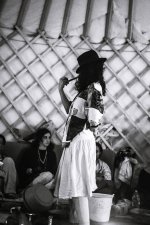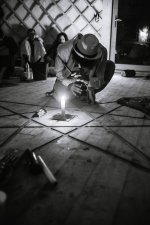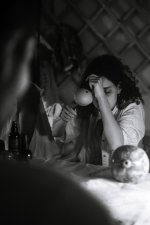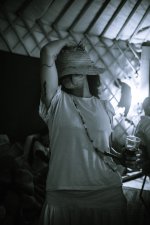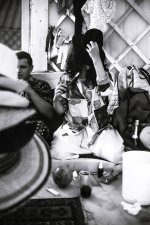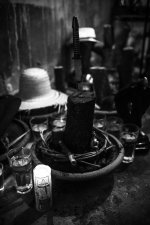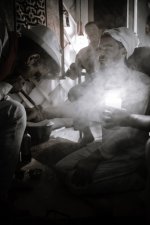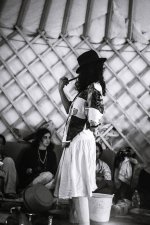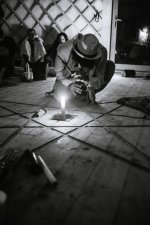donfoolio
Established member
.... Deep in the enchanted forest lies a well-guarded secret, with it's branches so thick and it's skin so thorny, that you cannot easily see the truth behind it's blooming appealing: Jurema.
What Jurema really is cannot easily be described in earthly words:
It is merely a principle fluctuating between reality and dreams, material and psychic worlds, microcosm and macrocosm.
Jurema is a spiritual guide, an entity, even a phalanx of entities, it is a city in the realms of the imaginary, a whole agglomeration of visionary estates. It is a cult, a science, but it is also a plant and a beverage.
The first recorded mentions of the cult of the Jurema Sagrada , that has become known as Catimbo, dates back to the 18th century, but little is really understood about its origins, its historical implications and its very secrets.
Even in Brazil, the cult of Catimbo is rather obscure and most often classified in the not completely defined category of Macumba:
folk black magic, sorcery and malveloent practices in the eye of the uninitiated.
Of course, this is a cult of initiation. To become a Jumereiro, a specific set of rituals is necessary among a years long training in medium ship and study of the complex and multifaceted cosmology of this unique syncretic practice.
African diaspora religions mixed with European sorcery, "la brujeria", Amazonian shamanism and the spiritism of Allen Kardec builds the ingredients of the explosive mixture and everybody that comes up just for "a good time in search of his real self" will readily be exploded in a thousand pieces of ego destruction and doubt.
The popularity of Catimbo in rural as well as urban areas are drown from the colourful universe of it's entities directly coming out of the underground:
Gamblers, gangsters, prostitutes, drunkards anr other nightlife figures.
These spirits are mixed in a manner typical for Afro-Brazilian syncretism with the ancestral spirits of the forest, who first have known about the beverage of jurema, the caboclos.
Descendants of mestizio and Indian lines.
Then shakes up well with the old blacks (preto velhos), and mixed toughly together with the legions of Exu and Pomba Gira -; the cult mixing elements of African veneration of the trickster messaneger Exu/elleggua with European demonology and witchcraft, that has been imported to Brazil through grimoires like the Petit Albert or the Book of St. Cyprian.
Beyond all of this obscure syncretism lies the dynamic concept herself:
The mysterious entity, plant and enchantress Jurema.
"And if you gaze long enough in an abyss, the abyss will gaze back into you"
- Nietzsche
Jurema is based on the ceremonial ingestion of a beverage made from the roots of Mimosa hostillis. Accompanied by the ritual use of tobacco blown in a reverse sense from a pipe made of the thick wood made from Jurema wood, like it first had been described in the 1940's by Carlos Estevaõ.
In this very decade Dimethyltryptamine was extracted from the core of the inner root bark of this holy tree, threated under the name of "Nigerine".
It was only later that researchers realized that the active principle of this plant is identical to so far synthetical produced DMT.
Anyway, the typical ritual of Catimbo consists of the consumption of Vinho de Jurema in a clearly defined setting to get in a state of ecstasy, accompanied by ecstatic chants and music to invoke the spirits of the estates of Jurema. A typical spirit-possession based cult, but trytaminesque in nature and followed by the rhythm of the maraca and the atabaque.
The ceremonies will most of the time have a character sprung out directly from a cabaret, with lots of travestie and costumes, alcoholic beverages and cigarettes. The spirits are always ready for a good drink and smoke.
"Where the hell I've been landed?" was the first question I asked to myself when I undertook the adventure of partaking in a ceremony the first time.
The Catimbo was without any doubt a Brazilian Bazooka circus. With its mediums dancing in gypsy clothes and drag queen outfits, submerged in the heights of an approximate ingestion of almost 200mg of Dimethyltryptamine and a vaguely dosed extract of betacarbolines, summing up with a pure Dmt joint mixed with some herbs at the peak of a famous song from the Bahia region. "This is the final trip" I said to myself, falling in a deep trance for one hour while continuing to participate in a spectacle of outgrown adults transforming themselves in gypsies sorcerer's, wild going Indians and prostitutes.
"We need to hold the table" said my friend.
One of the famous rituals of Catimbo is the mesa, the table, a kind of psychedelic version of the 19th century spiritist sessions, where every participant is posed around one big table in attempt for the spirits to come.
Within two hours, everybody was in full possession, has 'become a horse' like they say and started dancing and twisting around the table.
"Of course, we need to hold the table" - otherwise these bunch of outlawed gipsies will smash around everything holy to the sacred church and it's allies in a violent tornado of trance, ecstasy and drug abuse.
I lost my mention of time.
"Jurema cienca nobre, manaka nobreza Pura. "
"Of course, this is science. This is the direct experience of the archetypal forces in a setting that allows outstanding people to investigate and analyse what is going on and get in contact with their primary forces " I said to myself. In some sense. Or did jurema speak to me? I can't remember.
But it was also the connection to a year old tradition, geographically unidentified, put together by some centuries of ignorance and inquisition.
"Jurema is the feiticeira" they are repeating endlessly in the chants.
The visions were clear and explicit.
Witchcraft was the original craft in human entrepreneurship. A philosohy dedicated to the forest and its forces.
The manner in which the spirits are called is surreal. "vem,
Vem, vem"
It only needs a little pression in Stakkato and Tremolo and the "tour est joué".
The ghost had come down, ready to ride his horse. If only anyone would be kind enough to lit him a cigarette and serve him a glass of rum. ...
...minutes later the medium will go outside, vomiting the residue of the spirits pleasure, not reallt compatible with a normal mans consumption, especially after the ingestion of hige doses of ayahuasca.
maybe the medium is the message, but the medium is clearly a form of sacrifice.
The cult of Catimbo is based around Jurema preta, Mimosa hostillis or Mimosa tenuiflora, but several other plants are equally sacred and used in the ritual.
To my questioning, the father of the saints replied to me, that a mot of the knowledge about the ancient plants had been lost.
What Jurema really is cannot easily be described in earthly words:
It is merely a principle fluctuating between reality and dreams, material and psychic worlds, microcosm and macrocosm.
Jurema is a spiritual guide, an entity, even a phalanx of entities, it is a city in the realms of the imaginary, a whole agglomeration of visionary estates. It is a cult, a science, but it is also a plant and a beverage.
The first recorded mentions of the cult of the Jurema Sagrada , that has become known as Catimbo, dates back to the 18th century, but little is really understood about its origins, its historical implications and its very secrets.
Even in Brazil, the cult of Catimbo is rather obscure and most often classified in the not completely defined category of Macumba:
folk black magic, sorcery and malveloent practices in the eye of the uninitiated.
Of course, this is a cult of initiation. To become a Jumereiro, a specific set of rituals is necessary among a years long training in medium ship and study of the complex and multifaceted cosmology of this unique syncretic practice.
African diaspora religions mixed with European sorcery, "la brujeria", Amazonian shamanism and the spiritism of Allen Kardec builds the ingredients of the explosive mixture and everybody that comes up just for "a good time in search of his real self" will readily be exploded in a thousand pieces of ego destruction and doubt.
The popularity of Catimbo in rural as well as urban areas are drown from the colourful universe of it's entities directly coming out of the underground:
Gamblers, gangsters, prostitutes, drunkards anr other nightlife figures.
These spirits are mixed in a manner typical for Afro-Brazilian syncretism with the ancestral spirits of the forest, who first have known about the beverage of jurema, the caboclos.
Descendants of mestizio and Indian lines.
Then shakes up well with the old blacks (preto velhos), and mixed toughly together with the legions of Exu and Pomba Gira -; the cult mixing elements of African veneration of the trickster messaneger Exu/elleggua with European demonology and witchcraft, that has been imported to Brazil through grimoires like the Petit Albert or the Book of St. Cyprian.
Beyond all of this obscure syncretism lies the dynamic concept herself:
The mysterious entity, plant and enchantress Jurema.
"And if you gaze long enough in an abyss, the abyss will gaze back into you"
- Nietzsche
Jurema is based on the ceremonial ingestion of a beverage made from the roots of Mimosa hostillis. Accompanied by the ritual use of tobacco blown in a reverse sense from a pipe made of the thick wood made from Jurema wood, like it first had been described in the 1940's by Carlos Estevaõ.
In this very decade Dimethyltryptamine was extracted from the core of the inner root bark of this holy tree, threated under the name of "Nigerine".
It was only later that researchers realized that the active principle of this plant is identical to so far synthetical produced DMT.
Anyway, the typical ritual of Catimbo consists of the consumption of Vinho de Jurema in a clearly defined setting to get in a state of ecstasy, accompanied by ecstatic chants and music to invoke the spirits of the estates of Jurema. A typical spirit-possession based cult, but trytaminesque in nature and followed by the rhythm of the maraca and the atabaque.
The ceremonies will most of the time have a character sprung out directly from a cabaret, with lots of travestie and costumes, alcoholic beverages and cigarettes. The spirits are always ready for a good drink and smoke.
"Where the hell I've been landed?" was the first question I asked to myself when I undertook the adventure of partaking in a ceremony the first time.
The Catimbo was without any doubt a Brazilian Bazooka circus. With its mediums dancing in gypsy clothes and drag queen outfits, submerged in the heights of an approximate ingestion of almost 200mg of Dimethyltryptamine and a vaguely dosed extract of betacarbolines, summing up with a pure Dmt joint mixed with some herbs at the peak of a famous song from the Bahia region. "This is the final trip" I said to myself, falling in a deep trance for one hour while continuing to participate in a spectacle of outgrown adults transforming themselves in gypsies sorcerer's, wild going Indians and prostitutes.
"We need to hold the table" said my friend.
One of the famous rituals of Catimbo is the mesa, the table, a kind of psychedelic version of the 19th century spiritist sessions, where every participant is posed around one big table in attempt for the spirits to come.
Within two hours, everybody was in full possession, has 'become a horse' like they say and started dancing and twisting around the table.
"Of course, we need to hold the table" - otherwise these bunch of outlawed gipsies will smash around everything holy to the sacred church and it's allies in a violent tornado of trance, ecstasy and drug abuse.
I lost my mention of time.
"Jurema cienca nobre, manaka nobreza Pura. "
"Of course, this is science. This is the direct experience of the archetypal forces in a setting that allows outstanding people to investigate and analyse what is going on and get in contact with their primary forces " I said to myself. In some sense. Or did jurema speak to me? I can't remember.
But it was also the connection to a year old tradition, geographically unidentified, put together by some centuries of ignorance and inquisition.
"Jurema is the feiticeira" they are repeating endlessly in the chants.
The visions were clear and explicit.
Witchcraft was the original craft in human entrepreneurship. A philosohy dedicated to the forest and its forces.
The manner in which the spirits are called is surreal. "vem,
Vem, vem"
It only needs a little pression in Stakkato and Tremolo and the "tour est joué".
The ghost had come down, ready to ride his horse. If only anyone would be kind enough to lit him a cigarette and serve him a glass of rum. ...
...minutes later the medium will go outside, vomiting the residue of the spirits pleasure, not reallt compatible with a normal mans consumption, especially after the ingestion of hige doses of ayahuasca.
maybe the medium is the message, but the medium is clearly a form of sacrifice.
The cult of Catimbo is based around Jurema preta, Mimosa hostillis or Mimosa tenuiflora, but several other plants are equally sacred and used in the ritual.
To my questioning, the father of the saints replied to me, that a mot of the knowledge about the ancient plants had been lost.
Last edited:


